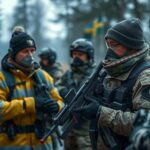Nordic Countries Strengthen Civil Defense Amid Ukraine Conflict
Nordic nations are ramping up civil defense measures amid the Ukraine war, focusing on citizen preparedness alongside military enhancements. New guides have been issued in Finland, Sweden, and Norway, emphasizing the importance of emergency readiness, with varying public sentiments on the perceived urgency. Historical traditions of civil preparedness are being updated to foster resilience against potential threats, reflecting a commitment to national security in an evolving geopolitical landscape.
Nordic countries are enhancing their civil defense in response to the heightened security concerns stemming from the ongoing war in Ukraine. As they bolster their military capabilities through increased defense budgets and NATO membership, nations such as Finland, Sweden, and Norway are also prioritizing the preparedness of their citizens. Updated preparedness guides have been distributed, detailing essential measures for emergency situations, including stockpiling food and water and responding to potential evacuations.
Finland’s guide focuses on general crisis readiness, while Norway emphasizes public participation in emergency preparedness. Conversely, Sweden’s guide is specifically titled “In Case of Crisis or War,” addressing the pressing threat of armed conflict, terrorism, and cyberattacks. Mikael Frisell, the director-general of Sweden’s Civil Contingencies Agency, articulated the imperative for heightened resilience among the populace due to the evolving national security landscape.
The Nordic countries have a long-standing tradition of civil defense dating back to World War II, reflected in their current guides that build upon existing protocols. Despite the lack of direct military threats, the unpredictability of global security situations necessitates such preparedness measures. For instance, Jussi Korhonen, the Finnish director of civil preparedness, emphasized that cultivating a prepared populace is an ongoing endeavor rather than a finite project.
Response to the guides has been varied. In Finland, approximately 400,000 individuals have downloaded the preparedness guide, with 60 percent of citizens already possessing essential emergency supplies. Young adults have been identified as the demographic least prepared for emergencies. In contrast, sentiment in Sweden exhibits a more relaxed attitude toward potential threats, with individuals like David Ferm expressing a belief that the public’s anxiety will likely diminish once the guides are fully disseminated. Ludvig Karlberg similarly noted that many do not perceive the war in Ukraine as directly affecting Sweden, despite growing fears regarding Russian aggression.
Conversely, those residing near the Russian border in Finland exhibit a heightened sense of urgency. Individuals such as Marika Kesseli acknowledge the importance of preparedness for military conflicts, despite the difficulties such conversations entail within their communities. Overall, while there exists a spectrum of sentiment across the Nordic countries, the overarching trend points towards a concerted effort to enhance civil defense and citizen readiness in light of regional instabilities.
The backdrop of this discussion involves the ongoing war in Ukraine, which has shifted the security dynamics in Northern Europe. As countries in close proximity to Russia, including Finland, Sweden, and Norway, confront these challenges, they recognize the necessity of not only military preparedness but also civilian readiness for various emergencies. This historical perspective on civil defense is informed by past conflicts, such as World War II and the Cold War, shaping the contemporary responses of Nordic nations to current threats.
In conclusion, Nordic countries are proactively adjusting their civil defense strategies in response to the escalating tensions stemming from the war in Ukraine. The emphasis on citizen preparedness, as evidenced by updated guides and outreach efforts, illustrates a comprehensive approach to national security that extends beyond military capabilities. While public perception varies, particularly between populations near the Russian border and those in more distant areas, the common goal remains to ensure resilience and readiness in uncertain times.
Original Source: www.dw.com








Post Comment